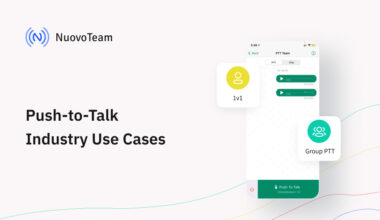The push-to-talk (PTT) technology has supported field and frontline communication for decades. Construction, mining, warehousing, emergency services, logistics, and transportation are some examples of remote industries that have seldom relied on popular modes of communication, like phone calls and emails. These industries have always preferred the simplicity and speed delivered by push-to-talk devices.
With time, traditional push-to-talk has evolved into smart push-to-talk that offers reliable communication and a highly functional feature set for employees to stay connected from anywhere. Unlike traditional PTT radios that presented coverage restrictions and poor audio quality, smart PTT allows users to download a mobile app on their smartphones to turn them into walkie-talkies. Smart PTT functions on push-to-talk over cellular (PoC) help employees connect with anyone nationwide or worldwide with just the press of a button.
Considering the immense benefits that smart PTT apps bestow on modern businesses, it does not come as a surprise that several businesses are rapidly adopting these tools. But to make the most of modern technology, it is vital that businesses understand the challenges and ensure proper usage. Security and privacy, for example, are non-negotiable in the modern business world.
Businesses worldwide are taking huge measures to protect their data and privacy. There are legislations across the world that enforce data security and privacy like the GDPR, HIPAA, and PDPA. With so much emphasis on security, businesses act carefully before picking their modern business tools.
6 Common PTT App Mistakes that Threaten Your Conversation Security
1. Picking an Unsecure PTT App
Smart PTT apps are more reliable and secure than traditional PTT radios since they use encrypted cellular networks. However, with the growing cybercrime, no amount of security is too much. Picking an informal PTT platform that does not do much to secure communication may be a terrible idea in this age. The fewer layers of security, the easier it is for hackers to intercept your sensitive business communication.
How NuovoTeam helps: NuovoTeam offers 128-bit encryption on all the communication that takes place from the platform. This, paired with an encrypted cellular network, offers extra protection against eavesdropping.
2. Avoiding Password Protection
Field employees can get a little negligent when using smartphones as walkie-talkies. Especially if they are their personal smartphones. Protecting every device that stores business information is essential to prevent sensitive information and private conversations from falling into the wrong hands.
How NuovoTeam helps: NuovoTeam allows admins to enforce a passcode policy on their employee devices. The passcode policy ensures that your employees maintain a strong password and renew it regularly.
3. Not Exploring RBAC
Businesses that have distributed teams and large workforces need better control of their devices, employees and policies. Large organizations entrust their IT staff to configure devices, push corporate policies, and monitor the remote workforce. Assigning specific roles and permissions to supervisors goes a long way in streamlining control and management of the distributed workforce. This is where role-based access control or RBAC comes into the picture. Additionally, understanding the cost to develop an app that includes RBAC features is crucial for budgeting.
How NuovoTeam helps: NuovoTeam allows the super admin to create multiple admins and assign permissions based on their roles. With this, limited people within the organization have access to the backend console of your PTT app and can better define rules that align with the organizational requirements.
4. Neglecting Closed Group Communication
Smart PTT apps enable easy group communication. You can conduct barge calls for organization-wide broadcasts or connect with multiple people on a PTT call. Picking the right method of communicating information according to the sensitivity of the matter is crucial. Broadcasts are heard loudly by everyone within the earshot. If you relay sensitive information using broadcast channels, it may be the easiest way to leak your corporate information.
How NuovoTeam helps: NuovoTeam allows businesses to create multiple public or private channels for group communication. The private channels strictly involve the concerned employees. With this, all confidential information is kept private within a specific encrypted loop.
5. Not Using Tools to Control Smartphones
Modern-day business processes cannot be restricted to a single platform. Third-party integrations play a huge role in business success. Picking a PTT solution that offers easy third-party integrations with your favorite platforms can help simplify your management and streamline your corporate security measures.
How NuovoTeam helps: NuovoTeam allows businesses to integrate an MDM solution of their choice to simplify the deployment, management, and security of PTT apps. Integrating MDM solutions have massive security advantages for businesses. You can leverage MDM-enabled kiosk mode to turn employee devices into dedicated walkie-talkies, and you can push extensive security settings and restrict device usage to selective secure apps and websites.
6. Underestimating a Contingency Plan
Today’s security models cannot rely on security features alone. Your business needs to implement a solution that provides real-time insights, analytics, and alerts to help you stay vigilant and take corrective measures to ensure minimal disruption.
How NuovoTeam helps: NuovoTeam offers admins comprehensive analytics based on the employee locations, clock-in & clock-out details, and attendance. You can also configure geofence-based clock-ins and clock-outs to track their activities remotely.
Closing Lines
Are you ready to implement a smart PTT solution? Make sure to avoid the above-mentioned mistakes. Securing your private conversations isn’t only about picking a feature-rich platform, but also ensuring that your processes are stringent and employees are well-aware of the security best practices.







